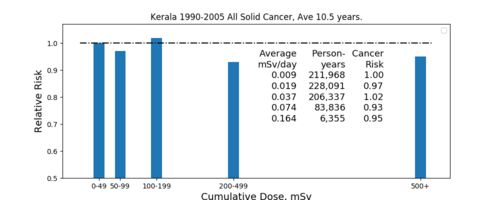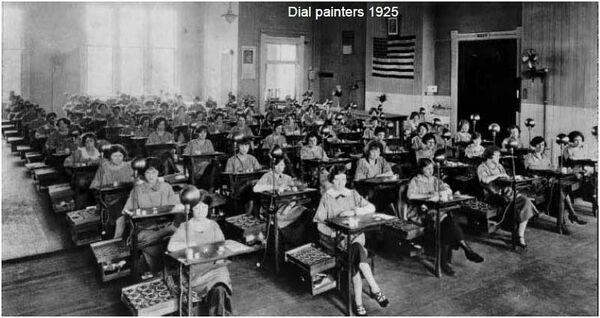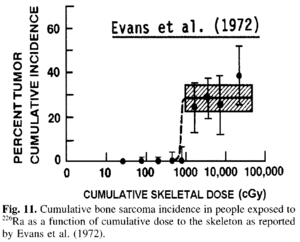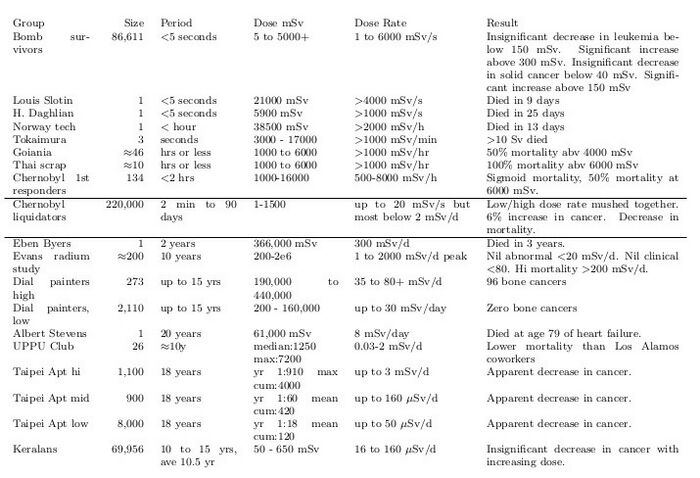User:Jess Brewer/sandbox/The Two Lies that Killed Nuclear Power
I am here transcribing an article on Gordian Knot News by Jack Devanney (with his permission) because I felt it needed wider exposure.
THE TWO LIES THAT KILLED NUCLEAR POWER[1].
We have been fed two lies about nuclear electricity by the nuclear power establishment.
The Teeny Weeny Lie:
The probability of a sizable release of radioactive material from a nuclear power plant is so low that we can just assume it won't happen.[2][3]
In the industry jargon, a large release is "not a credible event" or "virtually inconceivable" or "so small as to be almost negligible" or "vanishingly small". Whatever the wording, when a release occurs, public trust is lost for decades.
This is the lie we are all familiar with. It's a very stupid lie for it is obviously false. It was proven false at Three Mile Island, again at Chernobyl, and again at Fukushima. To provide a decent amount of reliable electricity to all humans on a fully decarbonized planet, we need something like 25,000 large nuclear plants, in the not too distant future. Based on past performance, a sizable release once every four thousand reactor-years, if nuclear power is truly successful, we can expect roughly 6 significant releases every year. Even if we can reduce the release frequency by a factor of 10 or 20, which we have no right to assume until we prove it, we will have a release every few years. Why would anybody promulgate a lie that was sure to be exposed? This brings us to The Cataclysm Lie.
The Cataclysm Lie:
Any significant release of radioactive material would be so catastrophic that it cannot be allowed to happen.
The origins of this lie go back to the aftermath of World War II. The intelligentsia had turned against nuclear weapons, and were seeking a means of halting nuclear weapons testing. Leading this fight was the Rockefeller Foundation. The Foundation felt personally responsible for the bomb. In their support of theoretical physics in the 1930's, they had funded almost all the Manhattan Project greats. Worse, they had single handedly funded the cyclotron at Berkeley. This proved critical to the creation of the bomb. The Foundation was determined to make amends.
The tool they chose to end weapons testing was the health hazards of radioactive fallout. Their problem was the dose rates associated with this fallout were a small fraction of the natural background radiation which all of us face each day.
We live in a sea of radiation. Every minute each of us is bombarded with a million or more radioactive particles which have the capability of disrupting the chemistry of our cells. In some high background areas, the hit rate can be ten million or more per minute. Fortunately, evolution has armed us with a slew of remarkably effective processes which repair this damage without our being aware of it. These repair processes can be overwhelmed if the dose rate is high enough; but, as we will see, such dose rates are difficult to achieve, even in a release as large as Fukushima.
Undeterred by these facts, the Rockefeller Foundation and its allies decided to argue that radiation produced genetic damage, the damage was unrepairable, and the amount of this damage was proportional to the total dose received regardless of how rapidly or slowly that dose was incurred. This is called the Linear No Threshold hypothesis or LNT.
If LNT were valid, then the anti-weapons testing forces could aggregate the tiny increase in dose rate due to fallout over hemispherical populations and over decades to argue that bomb testing was invisibly killing millions of people worldwide. The argument for LNT was based on experiments in which extremely high dose rates caused fruitfly mutations. The dose rates were over 100,000 times higher than would be encountered by the public in a power plant release.
The Foundation expertly promoted LNT with all its resources. This was done despite:
- LNT was contradicted by well established radiotherapy practices such as dividing a dose into fractions administered over a period of a week or so, to allow the healthy tissue to repair.
- In 1948, experimental attempts to extend the fruit fly results to lower dose rates revealed there was a threshold below which there was no detectable increase in mutation rates due to the radiation.
- In 1956, a ten year study of 70,000 atom bomb survivor pregnancies found no statistically detectable genetic damage to kids who were conceived after the bombs were dropped. The genetic harm theory crashed and burned. This forced the Foundation to shift its focus to radiation induced cancer, even though this required ignoring and suppressing highly non-linear leukemia numbers in the bomb survivor data.
The Foundation and it allies were successful. In 1959, the National Council on Radiation Protection, many of whose members were funded by the Foundation, recommended that radiation protection standards be based on LNT.
The Atomic Energy Commission did not have to accept this recommendation. They had funded the fruit fly research that contradicted LNT, the genetic study of the children of bomb survivors, and the non-linear bomb survivor cancer data. Nevertheless, rather than face the PR backlash that would have occurred due to the carefully orchestrated Rockefeller campaign if it had rejected the recommendation, the AEC decided to accept LNT as a realistic model of radiation harm.
One reason for this nearly inexplicable decision is that the nuclear power establishment had somehow convinced itself that, by carefully controlled design and stringent quality control, it could prevent a release. Since we were not going to have a release, what difference did it make what model of radiation harm was used?
This burst of corporate hubris put the AEC in an impossible bind. If LNT is valid and you combine it with a long chain of worst case assumptions, a large release could kill tens of thousands of people. So the nuclear establishment had to claim, or at least imply, that a significant release was never going to happen. The Cataclysm Lie begat The Teeny Weeny Lie.
Once the industry and the regulators promulgated this falsehood, they had to try to make it true. But there is no way you can prevent all releases. The Teeny Weeny Lie meant the nuclear establishment had to attempt the impossible. There is no limit to the amount of money that you can spend attempting the impossible. Or more precisely, the limit is when you make nuclear power prohibitively expensive. We reached that limit quickly.
Nuclear power emerged at just about the most difficult time possible economically. In the early-mid 1960's, the real cost of oil was at a all time low. The majors were buying oil in the Middle East at about a penny a liter. Oil was so cheap that it was pushing into electricity generation, the long time preserve of coal. This in turn forced the price of coal down, so it too was at an all time low. This was the cutthroat market that a technology that did not exist 15 years earlier, a technology that was just starting down a steep learning curve, had to enter and compete in. Amazingly, it did so. Thanks to nuclear's incredible energy density, these fledgling plants were able to produce electricity at 0.27 cents per kWh in 1970. That's less than 3 cents/kWh in 2020 money.
But the cost of nuclear power escalated rapidly. In the boom of the late 60's and early 70's, nuclear lost control of its costs. This was accompanied by regulatory attempts to ensure we would never have a release. These attempts led to ALARA (As Low As Reasonably Achievable), the principle that any exposure to radiation is unacceptable if the plant can afford to reduce it further. In other words, there are no lower limits. And the criterion is not whether the benefits of the reduction, if any, outweigh the costs. The criterion is: can the plant afford it? ALARA mandated the regulator to force the cost of nuclear power at least up to the cost of its competitors. ALARA quickly priced nuclear out of business. New nuclear plant ordering dried up in 1975. This was four years before Three Mile Island, a time during which nuclear power enjoyed strong public support, and the prohibitively expensive regulation enacted during the boom could not be rescinded. The regulatory ratchet only works in one direction.
The Cataclysm Lie is false. LNT is not a realistic model of radiation harm. The dose response curve is highly non-linear and critically dependent on dose rate. Cell-based laboratory experiments, extensive animal testing, and human study after human study detected no statistically reliable harm unless the dose rates are well above the natural background dose rates in the highest background areas. At very low dose rates, LNT is off by orders of magnitude.
Perhaps the most compelling background radiation study was done in Kerala, India. Radiation dose is measured in a unit called millisieverts, mSv. The average background daily dose on this planet is about 0.007 mSv/day. But the range is very large. In many areas, it is less than 0.003 mSv/day. Areas with a daily dose in excess of 0.03 mSv/day are common, and there are spots where the dose rate can be as high as 0.6 mSv/day.
The coastal belt of Kerala is such a high background area. Some locations on the shore have dose rates more than 0.2 mSv/day. 173,000 residents of this area were studied for 15 years. Figure 1 summarizes the results for the residents of an area with the lovely name of Karunagappally. The Karunagappallians who received 628 mSv over the period had a slightly lower cancer rate than their neighbors who received 35 mSv. Rates of 0.16 mSv/day for 15 years had no noticeable effect.
In certain artificial situations, humans can be exposed to much higher than background dose rates. Early radiologists calibrated their X-ray machines by sticking their arms into the beam. If the result was a reddening of the skin much like sunburn, the machine was about right. It's estimated that the reddening dose was 600 mSv. But the first public evidence of radiation harm was the radium dial painters.
Between 1915 and 1950, numerals on luminous watch dials were hand painted using radium paint for the most part by young women. Prior to about 1930, the ladies used their tongues to form the tip of the brush into a point, sipping radium into their bodies. Chemically radium is similar to calcium and accumulates in the bones. The total skeletal doses varied by over a factor of 1000. But the maximum cumulative dose was an incredible 444,000 mSv -- that is, 444 Sv.
In spite of the enormous cumulative doses, only two types of cancers were diagnosed: 64 bone cancers and 32 head carcinomas. Reliable dose measurements were available for 2,383 women. All the 96 cancers occurred in the 264 women with a net bone dose of more than 190,000 mSv. In 1935, the longest the ladies could have worked at this job was 20 years. The corresponding dose rate is at least 26 mSv/day. No bone cancers were found in the 2,110 women with less than 160,000 mSv net dose, Figure 3. The corresponding dose rate is at least 22 mSv/day. The ladies' repair systems could cope with roughly 20 mSv/day, but not a lot more.
Another example was the reprehensible experiments conducted by the Manhattan Project. In 1945, concerned about the health hazard of plutonium, which was being routinely handled by bomb workers, the US government injected 18 people, ages 4 to 69, with plutonium without their knowledge. All these people had been diagnosed with terminal disease. Eight of the 18 died within 2 years of the injection. All died from their pre-existing illness or cardiac failure. None died from the plutonium itself.
One of the involuntary subjects was Albert Stevens, a 58 year old house painter. Stevens had been misdiagnosed. His terminal stomach cancer turned out to be an operable ulcer. Stevens died at the age of 79 of heart failure, never knowing he had been injected. The researchers made every effort to maximize the damage. Stevens was injected directly into the blood stream with highly soluble, plutonium nitrate that had been spiked with Plutonium-238, which pumped the dose rate up by a factor of 20. Over the 21 year period between his injection and his death, Stevens' body received a cumulative dose of 64,000 mSv or 64 Sv. During this period, his body successfully coped with a dose rate of 8 mSv/day.
The UPPU Club was a group of 26 Manhattan project workers who had the highest level of plutonium in their urine, of all Manhattan workers. They were tracked into the 1990's. Their mortality rate was lower than both US white males and a sample of unexposed Manhattan workers.
More recently, recycled rebar, containing Cobalt-60, was accidentally used in the construction of 180 apartment buildings in Taiwan. Over 20 years, 8000 people received an average of 400 mSv each. The high dose cohort (about 11%) of the population received a mean cumulative dose of 4000 mSv with a max of 6000. The highest annual dose rate is estimated at 910 mSv/year. The cancers expected normally for this population is 115; the cancers actually observed was 95. According to LNT, we should have seen 153 cancers.
Table 1 summarizes the main studies that have been done on people who have received far larger than normal radiation doses. The atom bomb survivors absorbed their dose over a short period or acutely, in their case, in matter of seconds. The dose rates for the high dose cohorts were in the 1000 mSv per second range. In the bomb survivors, an acute dose in excess of about 200 mSv clearly increased cancer, and the incidence of cancer increased with further increasing dose. Below 100 mSv at these high dose rates, we see no or insignificant effect.
But in a nuclear power plant release, the dose is almost always spread over weeks and months and years, at least for the public. The public dose rates are almost never more than 1 mSv/d and for almost everybody far lower. In the jargon, these are called chronic doses. When we look at the groups that have received their dose chronically, we find that it almost does not matter how large the cumulative dose is as long as the dose rate is less than about 10 millisieverts per day. Only the radium dial painters whose dose rate exceeded 25 mSv/day developed bone cancer.
In Table 1, the acute dose groups are above the top horizontal line; the chronic dose groups are below the bottom line. The Chernobyl liquidators are a mixed bag. At least 4000 received their dose in a matter of minutes. For most of the others, the dose was spread over 60 to 90 days. Unfortunately, the individual dose profiles are not readily available.
Almost all the mortality is in the acute dose groups. Dose profile, how rapidly you receive your dose, is far more important than cumulative dose. This is consistent with what we know about cellular repair. What counts is the dose received within the repair period. The repair period is a few minutes to a day or two depending on the dose. It's also consistent with radiation regulation prior to 1950. Up to that point, both the US and international limit was 1 mSv/day. Table 1 says that looks about right, better than a factor of ten margin on detectable harm. Table 1 also says LNT is nonsense.
In the three large nuclear power plant releases to date, almost no member of the public exceeded a dose rate of 1 mSv/d.
- At TMI, the average additional dose in the area was about 0.015 mSv, a bit less than a one-way flight between New York and Los Angeles.
- At Fukushima, few if any members of the public received 1 mSv or more in a day. If there is any effect at all on the public from radiation, it will be undetectable. A risk you cannot detect is hardly a risk at all.
- Chernobyl was a far worse release than Fukushima. A conservative solid cancer model predicts a public Lost Life Expectancy from radiation of 1500 life years at Chernobyl but only 6 life-years at Fukushima. In addition, some kids received unnaturally high thyroid doses due to drinking contaminated milk. These deaths could easily have been prevented by a combination of iodine pills and temporarily banning local milk consumption. The isotope that causes this problem disappears in a month or so. Best estimates are 15 deaths from thyroid cancer.
Otherwise dose rates higher than 1 mSv/d at Chernobyl were restricted to plant workers, first responders, and a small portion of the clean up crew known as liquidators. About 30 people were killed in the first two groups. These people received more than 2000 mSv in a couple of hours. Some liquidators received doses in excess of 300 mSv over a short period. No immediate deaths, but we are seeing higher cancer rates in this group. However, their mortality rate is actually lower than average, presumably due to better detection and treatment. As for everybody else, a 2019 study by the Harvard Medical School found that the cancer mortality rates in the Ukraine districts closest to Chernobyl were no different statistically than those for the entire country.
Bottom line: even in a very large power plant release, dose rates to the public are almost never higher than the dose rates our bodies know how to handle. The Cataclysm claim is false.
Once we renounce the Cataclysm Lie, we no longer have any need for the patently false, trust sapping Teeny Weeny Lie. An occasional release is tolerable. Now nuclear power can regulated much like any other highly beneficial, hazardous activity. But this will only happen if the nuclear power establishment publicly and unequivocally renounces both their lies.
Unfortunately, there is no way the current US nuclear establishment will renounce either lie. Once the establishment embraced LNT, nuclear power was doomed. LNT resulted in ALARA. ALARA quickly priced nuclear power out of business. At that point, the nuclear power establishment turned to fear of radiation to keep the taxpayer dollars flowing. Unless near background dose rates are intolerably dangerous:
- The nuclear waste problem practically disappears.
- No one gets paid tens of billions of dollars a year for attempting to clean up sites where the contamination results in dose rates that are well below background in large parts of the planet.
- The 20 billion dollar per year National Lab complex left over from the Manhattan Project has little reason to exist.
- The civilian portion of the Department of Energy largely disappears.
- Most of the current NRC regulatory apparat disappears.
- Providing nuclear electricity could become a competitive business.
For the US nuclear establishment, abandoning the Cataclysm Lie would be suicidal. And as long as you are promulgating the Cataclysm Lie, you need the Teeny Weeny Lie to stay in business.
- ↑ This paper is a synopsis of the far more detailed argument made in the book Why Nuclear Power has been a Flop, which can be downloaded from gordianknotbook.com
- ↑ The Japanese even have a word for this lie. They call it anzen shinwa, the safety myth.
- ↑ "Preliminary results suggest there will never be a major accident in a nuclear power plant. The odds on a major catastrophe were one in one billion to one in ten billion years for a given reactor." -- Dr. Herbert Kouts, Head of AEC Division of Reactor Safety to Associated Press, 1974-01-14



